Xianghao Yu
Flow Matching-Based Active Learning for Radio Map Construction with Low-Altitude UAVs
Sep 17, 2025Abstract:The employment of unmanned aerial vehicles (UAVs) in the lowaltitude economy necessitates precise and real-time radio maps for reliable communication and safe navigation. However, constructing such maps is hindered by the infeasibility of exhaustive measurements due to UAVs' limited flight endurance. To address this, we propose a novel active learning framework for low-altitude radio map construction based on limited measurements. First, a Plug-and-Play (PnP)-refined flow matching algorithm is introduced, which leverages flow matching as a powerful generative prior within a PnP scheme to reconstruct high-fidelity radio maps. Second, the generative nature of flow matching is exploited to quantify uncertainty by generating an ensemble of radio maps and computing the location-wise variance. The resulting uncertainty map guides a multi-objective candidate selection and then a trajectory is planned via utility-aware path search (UAPS), directing the UAV to the most informative locations while taking travel costs into account. Simulation results demonstrate that our method significantly outperforms the baselines, achieving more than a 70% reduction in normalized mean squared error (NMSE).
CRB-Rate Tradeoff for Bistatic ISAC with Gaussian Information and Deterministic Sensing Signals
Jul 29, 2025Abstract:In this paper, we investigate a bistatic integrated sensing and communications (ISAC) system, consisting of a multi-antenna base station (BS), a multi-antenna sensing receiver, a single-antenna communication user (CU), and a point target to be sensed. Specifically, the BS transmits a superposition of Gaussian information and deterministic sensing signals. The BS aims to deliver information symbols to the CU, while the sensing receiver aims to estimate the target's direction-of-arrival (DoA) with respect to the sensing receiver by processing the echo signals. For the sensing receiver, we assume that only the sequences of the deterministic sensing signals and the covariance matrix of the information signals are perfectly known, whereas the specific realizations of the information signals remain unavailable. Under this setup, we first derive the corresponding Cram\'er-Rao bounds (CRBs) for DoA estimation and propose practical estimators to accurately estimate the target's DoA. Subsequently, we formulate the transmit beamforming design as an optimization problem aiming to minimize the CRB, subject to a minimum signal-to-interference-plus-noise ratio (SINR) requirement at the CU and a maximum transmit power constraint at the BS. When the BS employs only Gaussian information signals, the resulting beamforming optimization problem is convex, enabling the derivation of an optimal solution. In contrast, when both Gaussian information and deterministic sensing signals are transmitted, the resulting problem is non-convex and a locally optimal solution is acquired by exploiting successive convex approximation (SCA). Finally, numerical results demonstrate that employing Gaussian information signals leads to a notable performance degradation for target sensing and the proposed transmit beamforming design achieves a superior ISAC performance boundary compared with various benchmark schemes.
Joint Radiation Power, Antenna Position, and Beamforming Optimization for Pinching-Antenna Systems with Motion Power Consumption
Jul 03, 2025Abstract:Pinching-antenna systems (PASS) have been recently proposed to improve the performance of wireless networks by reconfiguring both the large-scale and small-scale channel conditions. However, existing studies ignore the physical constraints of antenna placement and assume fixed antenna radiation power. To fill this research gap, this paper investigates the design of PASS taking into account the motion power consumption of pinching-antennas (PAs) and the impact of adjustable antenna radiation power. To that end, we minimize the average power consumption for a given quality-of-service (QoS) requirement, by jointly optimizing the antenna positions, antenna radiation power ratios, and transmit beamforming. To the best of the authors' knowledge, this is the first work to consider radiation power optimization in PASS, which provides an additional degree of freedom (DoF) for system design. The cases with both continuous and discrete antenna placement are considered, where the main challenge lies in the fact that the antenna positions affect both the magnitude and phase of the channel coefficients of PASS, making system optimization very challenging. To tackle the resulting unique obstacles, an alternating direction method of multipliers (ADMM)-based framework is proposed to solve the problem for continuous antenna movement, while its discrete counterpart is formulated as a mixed integer nonlinear programming (MINLP) problem and solved by the block coordinate descent (BCD) method. Simulation results validate the performance enhancement achieved by incorporating PA movement power assumption and adjustable radiation power into PASS design, while also demonstrating the efficiency of the proposed optimization framework. The benefits of PASS over conventional multiple-input multiple-output (MIMO) systems in mitigating the large-scale path loss and inter-user interference is also revealed.
Millimeter-Wave Energy-Efficient Hybrid Beamforming Architecture and Algorithm
Jan 03, 2025Abstract:This paper studies energy-efficient hybrid beamforming architectures and its algorithm design in millimeter-wave communication systems, aiming to address the challenges faced by existing hybrid beamforming due to low hardware flexibility and high power consumption. To solve the problems of existing hybrid beamforming, a novel energy-efficient hybrid beamforming architecture is proposed, where radio-frequency (RF) switch networks are introduced at the front and rear ends of the phase shifter network, enabling dynamic connections between the RF chains and the phase shifter array as well as the antenna array. The system model of the proposed architecture is established, including digital precoding and analog precoding processes, and the practical hardware limitations such as quantization errors of the digital-to-analog converter (DAC) and phase shifter resolution. In order to maximize the energy efficiency, this paper derives an energy efficiency model including spectral efficiency and system power consumption, and a hybrid precoding algorithm is proposed based on block coordinate descent to iteratively optimize the digital precoding matrix, analog precoding matrix, and DAC resolution. Simulation results under the NYUSIM-generated millimeter-wave channels show that the proposed hybrid beamforming architecture and precoding algorithm have higher energy efficiency than existing representative architectures and precoding algorithms under complete and partial channel state information, while the loss of spectral efficiency compared to fully connected architecture is less than 20%
* 21 pages, in Chinese language, 8 figures, published to Mobile Communications
Integrated Sensing and Communications for Low-Altitude Economy: A Deep Reinforcement Learning Approach
Dec 05, 2024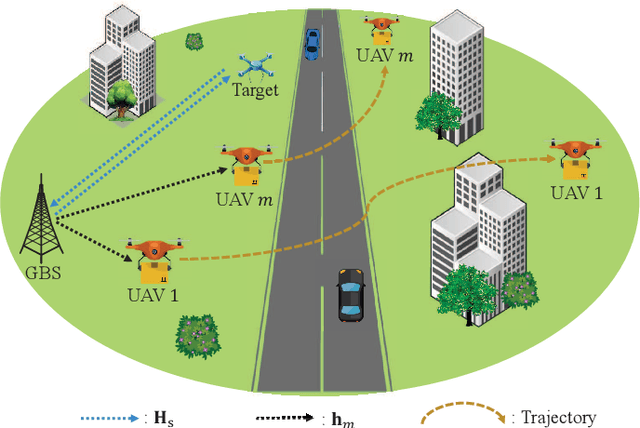
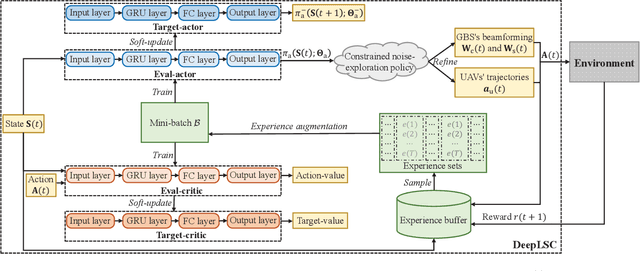
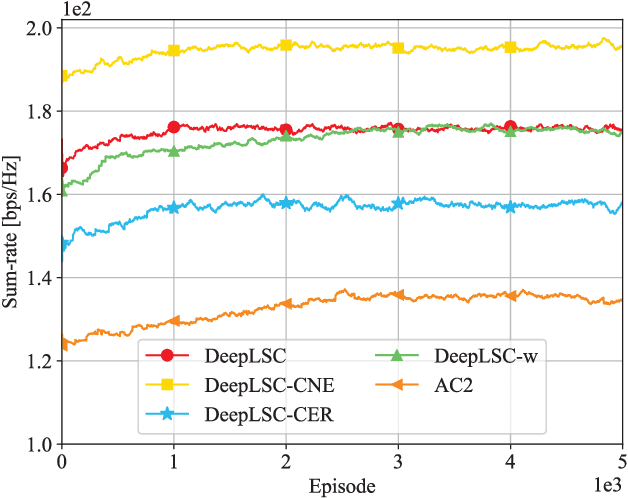
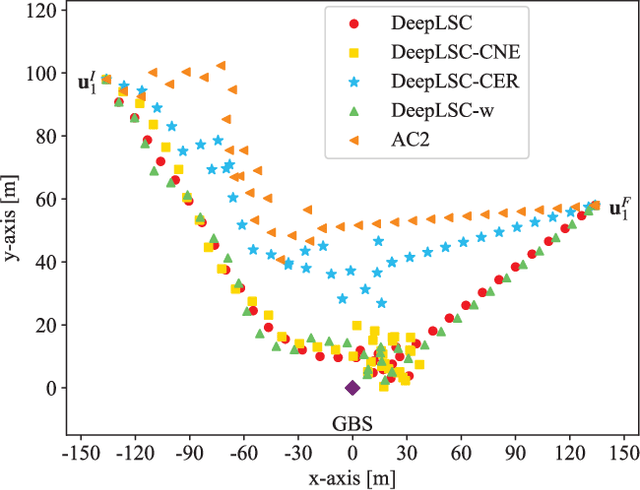
Abstract:This paper studies an integrated sensing and communications (ISAC) system for low-altitude economy (LAE), where a ground base station (GBS) provides communication and navigation services for authorized unmanned aerial vehicles (UAVs), while sensing the low-altitude airspace to monitor the unauthorized mobile target. The expected communication sum-rate over a given flight period is maximized by jointly optimizing the beamforming at the GBS and UAVs' trajectories, subject to the constraints on the average signal-to-noise ratio requirement for sensing, the flight mission and collision avoidance of UAVs, as well as the maximum transmit power at the GBS. Typically, this is a sequential decision-making problem with the given flight mission. Thus, we transform it to a specific Markov decision process (MDP) model called episode task. Based on this modeling, we propose a novel LAE-oriented ISAC scheme, referred to as Deep LAE-ISAC (DeepLSC), by leveraging the deep reinforcement learning (DRL) technique. In DeepLSC, a reward function and a new action selection policy termed constrained noise-exploration policy are judiciously designed to fulfill various constraints. To enable efficient learning in episode tasks, we develop a hierarchical experience replay mechanism, where the gist is to employ all experiences generated within each episode to jointly train the neural network. Besides, to enhance the convergence speed of DeepLSC, a symmetric experience augmentation mechanism, which simultaneously permutes the indexes of all variables to enrich available experience sets, is proposed. Simulation results demonstrate that compared with benchmarks, DeepLSC yields a higher sum-rate while meeting the preset constraints, achieves faster convergence, and is more robust against different settings.
An Overview on IRS-Enabled Sensing and Communications for 6G: Architectures, Fundamental Limits, and Joint Beamforming Designs
Nov 11, 2024



Abstract:This paper presents an overview on intelligent reflecting surface (IRS)-enabled sensing and communication for the forthcoming sixth-generation (6G) wireless networks, in which IRSs are strategically deployed to proactively reconfigure wireless environments to improve both sensing and communication (S&C) performance. First, we exploit a single IRS to enable wireless sensing in the base station's (BS's) non-line-of-sight (NLoS) area. In particular, we present three IRS-enabled NLoS target sensing architectures with fully-passive, semi-passive, and active IRSs, respectively. We compare their pros and cons by analyzing the fundamental sensing performance limits for target detection and parameter estimation. Next, we consider a single IRS to facilitate integrated sensing and communication (ISAC), in which the transmit signals at the BS are used for achieving both S&C functionalities, aided by the IRS through reflective beamforming. We present joint transmit signal and receiver processing designs for realizing efficient ISAC, and jointly optimize the transmit beamforming at the BS and reflective beamforming at the IRS to balance the fundamental performance tradeoff between S&C. Furthermore, we discuss multi-IRS networked ISAC, by particularly focusing on multi-IRS-enabled multi-link ISAC, multi-region ISAC, and ISAC signal routing, respectively. Finally, we highlight various promising research topics in this area to motivate future work.
Exploiting Moving Arrays for Near-Field Sensing
Oct 12, 2024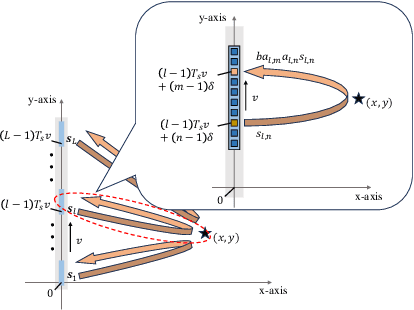



Abstract:This letter exploits moving arrays to enable nearfield multiple-input multiple-output (MIMO) sensing via a limited number of antenna elements. We consider a scenario where a base station (BS) is equipped with a uniform linear array (ULA) on a moving platform. The objective is to locate a point target in the two-dimensional (2D) space by leveraging the near-field channel characteristics created by the movement of antenna arrays. Under this setup, we analyze the Cramer-Rao bound (CRB) for estimating the target's 2D coordinate, which provides the fundamental sensing performance limits for localization. It is revealed that our proposed design with a moving array achieves a CRB that is proportional to the CRB obtained by an equivalent extremely large ULA matching the platform's size. This shows that the movement of antenna array significantly enlarges its effective aperture to enable near-field sensing. Numerical results show that the proposed moving array design substantially enhances the target estimation performance compared to the conventional fixed array benchmark.
Beamforming for PIN Diode-Based IRS-Assisted Systems Under a Phase Shift-Dependent Power Consumption Model
Aug 03, 2024



Abstract:Intelligent reflecting surfaces (IRSs) have been regarded as a promising enabler for future wireless communication systems. In the literature, IRSs have been considered power-free or assumed to have constant power consumption. However, recent experimental results have shown that for positive-intrinsic-negative (PIN) diode-based IRSs, the power consumption dynamically changes with the phase shift configuration. This phase shift-dependent power consumption (PS-DPC) introduces a challenging power allocation problem between base station (BS) and IRS. To tackle this issue, in this paper, we investigate a rate maximization problem for IRS-assisted systems under a practical PS-DPC model. For the single-user case, we propose a generalized Benders decomposition-based beamforming method to maximize the achievable rate while satisfying a total system power consumption constraint. Moreover, we propose a low-complexity beamforming design, where the powers allocated to BS and IRS are optimized offline based on statistical channel state information. Furthermore, for the multi-user case, we solve an equivalent weighted mean square error minimization problem with two different joint power allocation and phase shift optimization methods. Simulation results indicate that compared to baseline schemes, our proposed methods can flexibly optimize the power allocation between BS and IRS, thus achieving better performance. The optimized power allocation strategy strongly depends on the system power budget. When the system power budget is high, the PS-DPC is not the dominant factor in the system power consumption, allowing the IRS to turn on as many PIN diodes as needed to achieve high beamforming quality. When the system power budget is limited, however, more power tends to be allocated to the BS to enhance the transmit power, resulting in a lower beamforming quality at the IRS due to the reduced PS-DPC budget.
Multi-Active-IRS-Assisted Cooperative Sensing: Cramér-Rao Bound and Joint Beamforming Design
Jun 18, 2024Abstract:This paper studies the multi-intelligent reflecting surface (IRS)-assisted cooperative sensing, in which multiple active IRSs are deployed in a distributed manner to facilitate multi-view target sensing at the non-line-of-sight (NLoS) area of the base station (BS). Different from prior works employing passive IRSs, we leverage active IRSs with the capability of amplifying the reflected signals to overcome the severe multi-hop-reflection path loss in NLoS sensing. In particular, we consider two sensing setups without and with dedicated sensors equipped at active IRSs. In the first case without dedicated sensors at IRSs, we investigate the cooperative sensing at the BS, where the target's direction-of-arrival (DoA) with respect to each IRS is estimated based on the echo signals received at the BS. In the other case with dedicated sensors at IRSs, we consider that each IRS is able to receive echo signals and estimate the target's DoA with respect to itself. For both sensing setups, we first derive the closed-form Cram\'{e}r-Rao bound (CRB) for estimating target DoA. Then, the (maximum) CRB is minimized by jointly optimizing the transmit beamforming at the BS and the reflective beamforming at the multiple IRSs, subject to the constraints on the maximum transmit power at the BS, as well as the maximum amplification power and the maximum power amplification gain constraints at individual active IRSs. To tackle the resulting highly non-convex (max-)CRB minimization problems, we propose two efficient algorithms to obtain high-quality solutions for the two cases with sensing at the BS and at the IRSs, respectively, based on alternating optimization, successive convex approximation, and semi-definite relaxation.
Low-Complexity Near-Field Localization with XL-MIMO Sectored Uniform Circular Arrays
May 02, 2024Abstract:Rapid advancement of antenna technology catalyses the popularization of extremely large-scale multiple-input multiple-output (XL-MIMO) antenna arrays, which pose unique challenges for localization with the inescapable near-field effect. In this paper, we propose an efficient near-field localization algorithm by leveraging a sectored uniform circular array (sUCA). In particular, we first customize a backprojection algorithm in the polar coordinate for sUCA-enabled near-field localization, which facilitates the target detection procedure. We then analyze the resolutions in both angular and distance domains via deriving the interval of zero-crossing points, and further unravel the minimum required number of antennas to eliminate grating lobes. The proposed localization method is finally implemented using fast Fourier transform (FFT) to reduce computational complexity. Simulation results verify the resolution analysis and demonstrate that the proposed method remarkably outperforms conventional localization algorithms in terms of localization accuracy. Moreover, the low-complexity FFT implementation achieves an average runtime that is hundreds of times faster when large numbers of antenna elements are employed.
 Add to Chrome
Add to Chrome Add to Firefox
Add to Firefox Add to Edge
Add to Edge